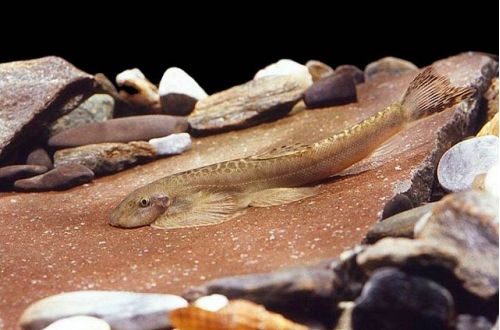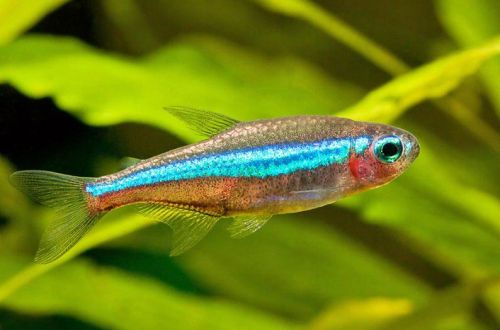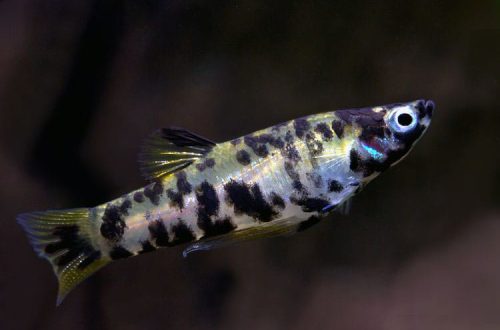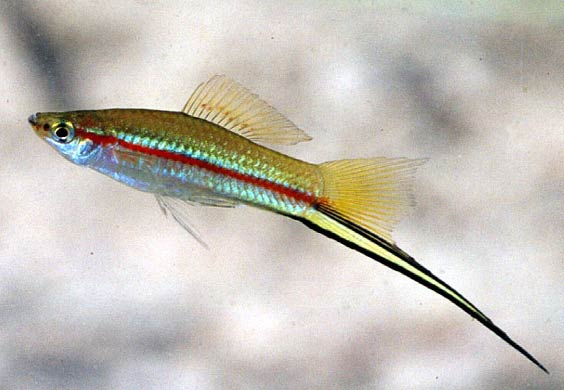
Green swordsman
The green swordtail, scientific name Xiphophorus hellerii, belongs to the Poeciliidae family. The Latin name is given in honor of the Austrian botanist and naturalist Karl Bartholomew Heller (1824–1880), who first discovered this species of fish in 1848, during an expedition to study the flora and fauna of Mexico.

In Europe, it first appeared in aquariums in 1909. Currently on sale are mainly various breeding varieties of various colors (red, black, etc.) and fin shapes. The “classic” Green swordsman is much less common.
Contents
Habitat
This species is native to Central America. The original natural habitat stretched from Mexico to Honduras. Fish inhabited numerous river systems flowing into the Atlantic Ocean.
Nowadays, due to the fault of aquarists, the distribution area has increased significantly. Swordtails can be found on almost all continents (with the exception of Antarctica) in the tropical and equatorial climatic zones.
Brief information:
- The volume of the aquarium – from 100 liters.
- Temperature – 16-28°C
- Value pH — 7.0–8.0
- Water hardness – soft to high (10-30 dGH)
- Substrate type – any
- Lighting – moderate or bright
- Brackish water is permissible in a salt concentration of up to 15 g per 1 liter
- Water movement – light or moderate
- The size of the fish is 14–16 cm.
- Food – any food
- Temperament – peaceful
- Content alone, in pairs or in a group
Description
The main characteristic of the species is the elongated lower rays of the tail, bordered by black lines, vaguely resembling a sword. Adult individuals reach a length of 14–16 cm, taking into account the tail-sword. The color is silvery with green turquoise hues. A purple stripe runs along the body. The dorsal fin and tail are yellow.

Males are smaller, brighter looking and have a characteristic modified anal fin, a tube-like gonopodium, through which fertilization occurs. Females are noticeably larger and do not have a “sword” on the caudal fin.
As mentioned above, there are many artificially bred breeds, including hybrids with Pecilia, which differ in color, body pattern and fin shape. The features of each variety are indicated in separate articles.
Food
In nature, they feed on small invertebrates (aquatic insects and their larvae, crustaceans), as well as algae and plant particles. Such omnivorousness allows the use of most feeds in dry, frozen and live form. Many manufacturers produce special foods designed for Swordtails, which can form the basis of a daily diet.
Maintenance and care, arrangement of the aquarium
The optimal size of the aquarium for 3-4 fish starts from 100 liters. The choice of design is not significant. However, it was noted that the fish feel best in an environment resembling the bottom of a river with a moderate current, stony substrates and snags. Lighting should not be too bright. Shading can be achieved by tall plants reaching and creeping over the surface.
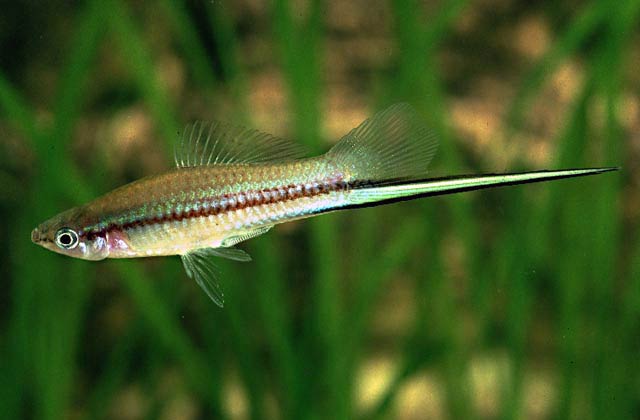
One of the main conditions for successful maintenance is to ensure high water quality in the allowable range of temperatures and values of hydrochemical parameters. To this end, the aquarium is equipped with the necessary equipment, primarily a filtration system, and a number of mandatory procedures are carried out. The latter include weekly replacement of water with fresh water, removal of organic waste (feed residues, excrement) and cleaning of design elements, side walls of the tank.
They can be found in conditions of low salinity at a concentration of up to 15 grams of salt per liter, which corresponds to half the salinity of sea water.
Behavior and Compatibility
Males compete with each other for position in the internal hierarchy and the attention of females. The rivalry is demonstrative. Skirmishes and injuries are excluded, so they can be classified as peaceful species. Compatible with many other calm non-aggressive fish of comparable size.
It is worth remembering that some fish, such as barbs, tend to bite off or damage the long fins of their tankmates. Given the peculiarities of the structure of the caudal fin in Green Swordtails, they can potentially suffer from the behavior of barbs.
Breeding / breeding
Under favorable conditions, spawning occurs regularly. In the artificial environment, seasonality is not expressed. During breeding, the alpha male circles around the female, demonstrating his readiness to mate. When the female is ready, she accepts courtship. Fertilization takes place inside the body. The fry appear fully formed, bypassing the stage of eggs. The incubation period lasts about a month.
The female controls fertilization herself, so in some cases she is able to store the male’s seed for several months. For example, if the water temperature drops or the fish no longer receive regular food (the owners went on vacation), then the fertilization process will be delayed.
Adult fish do not show parental care for offspring and can eat their own fry. To protect the brood, it is recommended to move it to a separate tank.
Fish diseases
Belongs to the number of hardy and unpretentious species. However, breeding varieties may be sensitive to habitat conditions and more susceptible to disease. When the first symptoms appear (lethargy, refusal of food, changes in the shape of the fins, body), the first thing to do is to check the composition of the water for the presence of dangerous concentrations of nitrogen cycle products, pH and GH values. Most often, the cause of diseases is unsuitable conditions of detention. If you bring all the indicators back to normal, then the immunity of the fish can independently cope with the disease. Otherwise, medical treatment will be required. Read more in the section “Diseases of aquarium fish”.



